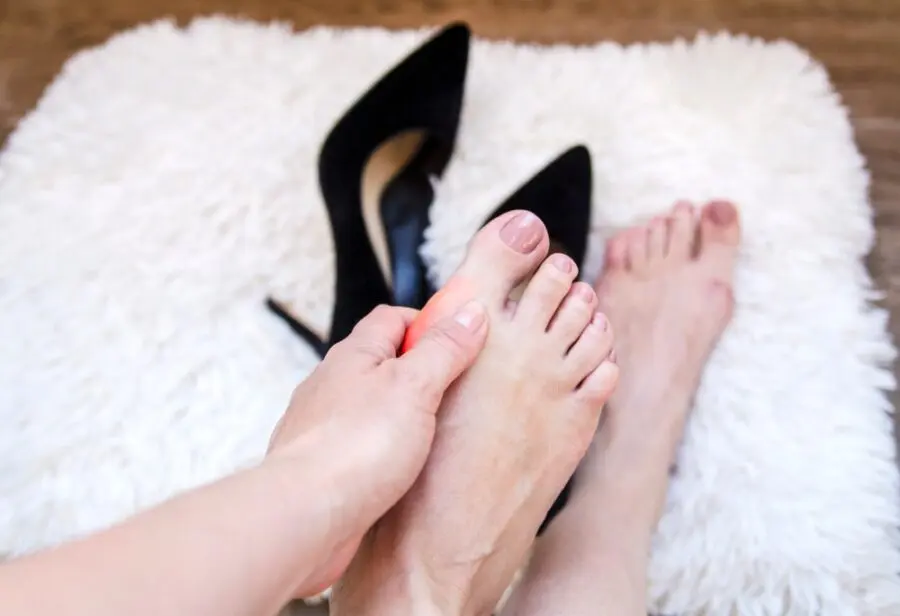
Osteoarthritis of the big toe is a degenerative condition that causes joint hardening and a progressive loss of mobility, which may be quite painful.
The most prevalent type of joint deterioration is osteoarthritis. The metatarsophalangeal joint of the big toe is affected by hallux rigidus.
If the big toe osteoarthritis is not treated, the front of the foot loses mobility and eventually freezes.
This disease can cause discomfort and deformity, making it difficult to wear shoes.
Osteoarthritis of the big toe, like many foot diseases, is simpler to treat if caught early.
Learn about the warning symptoms of hallux rigidus and how to avoid it by developing good habits.
Symptoms
The consequences of a hallux rigidus issue might be so severe that surgery is required.
This is why it’s critical to recognize the signs and symptoms of big toe osteoarthritis.
The presence of hallux rigidus may be indicated by the following symptoms:
- Joint deformities: Like hallux valgus (bunion of the foot), osteoarthritis of the big toe, if ignored, eventually leads to a bony growth. This osteophyte makes certain gestures painful.
- Progressive joint stiffness: Complementary to joint deformities, joint stiffness of the big toe worsens with the absence of treatment. It can even go so far as to completely prevent movement in this area of the foot.
- Localized pain in the affected big toe: As a result of the deformities and joint stiffness caused by hallux rigidus, the pain increases over time.
- Supination gait: Pain and rigidity of the big toe cause a walk on the outside of the foot.
If one or more of these symptoms appears, it is critical to act quickly to avoid irreparable consequences.
Causes and risk factors
The wear and tear of the cartilage that protects the bones of the metatarsophalangeal joint is what causes osteoarthritis of the big toe.
The bone gets exposed as the cartilage loses its effectiveness, resulting in friction when the joint is utilized.
Although many people are at risk for big toe osteoarthritis, certain habits or pathologies might hasten the disease’s onset:
- A flat foot or an “Egyptian” foot.
- Playing a sport that causes repeated trauma to the toes: Examples include ballet, tennis or running.
- Older age: Osteoarthritis that isn’t caused by sports wear and strain is common in the elderly.
- Heredity: Family history can play a role in the development of osteoarthritis.
- Being overweight: Excessive strain on the joints promotes the development of hallux rigidus.
- Poorly healed injury: A sports or accidental injury that is poorly managed can lead to foot deformities.
- Shoes that are too narrow: This type of shoe traps the foot and is an aggravating factor, as are high-heeled shoes.
Diseases like rheumatoid arthritis and gout can induce hallux rigidus in addition to physiological causes.
Preventing big toe osteoarthritis
Following the onset of symptoms of osteoarthritis of the big toe, it is advisable to consult a podiatrist for a diagnosis and targeted treatment.
Certain preventative actions, on the other hand, are within everyone’s reach:
- Adapt your shoes to avoid them being too small or not providing enough support for your feet.
- Limit your participation in sports that put too much strain on your joints, such as jogging, dancing, skiing, or soccer.
- Maintain a healthy weight to alleviate joint stress.
- Avoid wearing high-heeled shoes on a daily basis, as they limit the toes and promote abnormalities to develop.
- Opt for low-impact physical activities such as swimming or cycling.
Treatments and therapeutic methods
An acute pain that interferes with your everyday activities should never be ignored. Similar discomfort occurs during or after movement in advanced osteoarthritis of the big toe.
If this is the case, a podiatrist visit at a clinic is essential.
The podiatrist may utilize digital x-ray technology to determine the degree of the injury to further explain the diagnosis.
The podiatrist will next prescribe a treatment plan based on the severity of the foot damage:
- A prescription for anti-inflammatory or pain medication
- Intra-articular cortisone injections to treat the pain and inflammation at the source
- Foot orthoses to correct supination
In more serious situations, the podiatrist may recommend more intrusive treatments, like foot surgery.
The following are the most common operations for hallux rigidus:
- Metatarsophalangeal arthrodesis: a permanent blockage of the defective joint in order to restore mobility to the foot.
- Decompression osteotomy: requires the removal of a piece of bone to correct the axis of the affected toe.
Surgery, on the other hand, is a last resort. Early diagnosis and treatment by a podiatrist can assist to reduce the need for surgery.
PiedRéseau – Learn more
Are you interested in learning more about hallux rigidus? We have a wide range of material on the subject!
However, while the PiedRéseau website contains useful information, it is not a substitute for a professional visit at a podiatric clinic.
Take care of your feet, they’re precious!